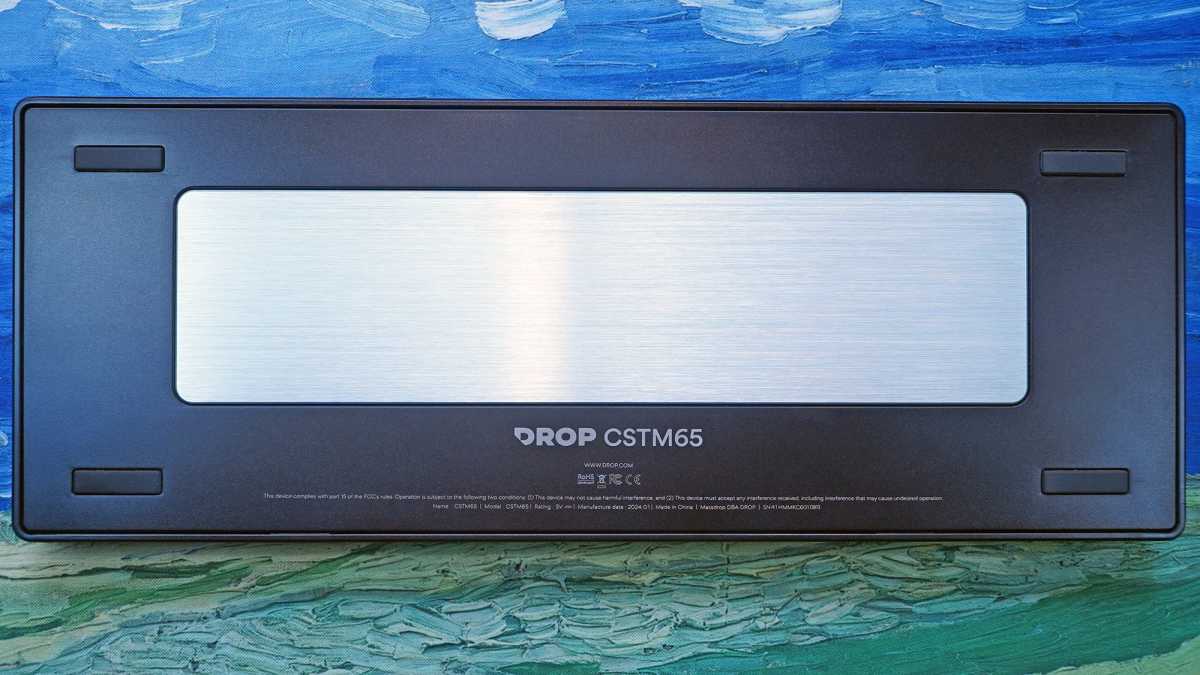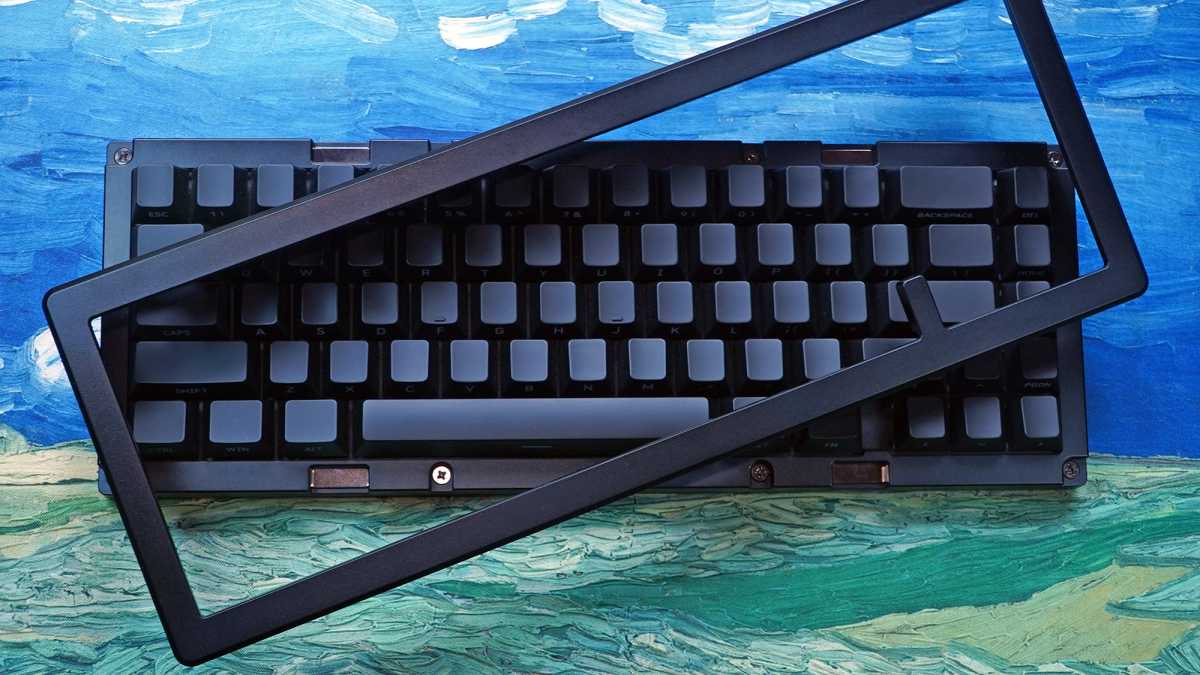Expert's Rating
Pros
- Amazingly easy customization
- Stylish lighting
- Semi-standard layout for keycaps
Cons
- Expensive base price and add-ons
- No adjustable feet
- ABS keycaps
Our Verdict
The CSTM65 lives up to its name, being extremely easy to disassemble and customize. It’s a solid middle ground between a full custom keyboard build and a regular retail design.
Best Prices Today: Drop.com CSTM65 Keyboard
One of the first mechanical keyboards I ever owned was bought from Massdrop. More recently the online store is just going by Drop.com, and even more recently it’s been acquired by an ever-hungry Corsair. I imagine it’s the latter that’s pushed it into making less expensive, more accessible designs like the CSTM65.
This board is all about customization: The switches, the software, and even the case can be upgraded without any special tools or knowledge. It’s a good middle step between a regular mechanical board and building your own…though it doesn’t offer a great value.
Further reading: See our roundup of the best mechanical keyboards to learn about competing products.
Unassuming looks
If the CSTM65 looks familiar, that might be by design. Its 65 percent layout, lack of branding, and all-black looks seem almost intentionally vague, as if meant to appeal to keyboard users who want to eschew the garish colors and logos of gaming boards. But there are a couple of distinctive touches, including shine-through keycaps with legends on the bottom to take full advantage of south-facing LEDs. It’s a nice, stealthy look, if that’s what you’re into.
This board is all about customization: The switches, the software, and even the case can be upgraded without any special tools or knowledge.
In terms of hardware, it’s pretty standard for boards in this market. It’s wired with a braided USB-C cord in the box, hot-swap switch sockets for changing out the key feel (you get either basic Gateron Brown tactile or Yellow linears by default), and some goodies like internal sound-absorbing foam and a gasket-mounted PCB. Again, pretty typical, but there’s nothing to complain about except perhaps a higher-than-average price tag.
Crack it open
But there are a few other parts that highlight this board’s customization focus. The 65 percent layout isn’t technically standard, but it’s about as close as it can be at this size. Only the 1.75u right Shift key is off from ANSI, and that’s a common enough inclusion for custom keycap sets (including Drop’s many branded options). A slightly larger version of this board, the CSTM80, comes in a standard tenkeyless (TKL) layout.

The stylish weighted bottom piece is aluminum out of the box, but you can upgrade this with steel or brass (sold separately).
The stylish weighted bottom piece is aluminum out of the box, but you can upgrade this with steel or brass (sold separately).
Michael Crider/Foundry
The stylish weighted bottom piece is aluminum out of the box, but you can upgrade this with steel or brass (sold separately).
Michael Crider/Foundry
<div class="scrim" style="background-color: #fff" aria-hidden="true"></div>
</div></figure><p class="imageCredit">Michael Crider/Foundry</p></div>The real wow factor is the case. Unplug the cable, lift up the sides, and the top comes right off, secured with a series of magnets. You can swap it out for other colors and accented designs available from Drop, or even a swanky aluminum replacement. With a few exposed screws removed, you can get to the keyboard’s internal circuit board, foam layers, and the bottom of the case, which also holds a replaceable weighted piece. The one in the box is aluminum, but you can upgrade it with chunky and heavy brass.

The top of the case pulls off easily from its magnetic mount, and the rest is easily accessible with a screwdriver.
The top of the case pulls off easily from its magnetic mount, and the rest is easily accessible with a screwdriver.
Michael Crider/Foundry
<div class="lightbox-image-container foundry-lightbox"><div class="extendedBlock-wrapper block-coreImage undefined"><figure class="wp-block-image size-large enlarged-image"><img decoding="async" data-wp-bind--src="selectors.core.image.enlargedImgSrc" data-wp-style--object-fit="selectors.core.image.lightboxObjectFit" src="" alt="CSTM65 case removed" class="wp-image-2392485" width="1200" height="676" loading="lazy" /><figcaption class="wp-element-caption"><p>The top of the case pulls off easily from its magnetic mount, and the rest is easily accessible with a screwdriver. </p></figcaption></figure><p class="imageCredit">Michael Crider/Foundry</p></div> </div></figure><p class="imageCredit">Michael Crider/Foundry</p></div>It’s just about as easy as any keyboard can be to work on and upgrade, far more so than any gaming board or even Keychron’s custom-focused Q series. If you’re into more intense customization, you can even remove the plastic plate and the screw-in stabilizers. Like I said, this is a very nice middle ground between building your own keyboard from the ground up and going with a more expensive custom-style or boutique build.
That said, there are a few corners cut. The default plastic case doesn’t feel great — it’s a little flimsy, aside from the brushed aluminum bottom plate. It’s also lacking any adjustable feet, an odd omission on a keyboard otherwise so happy to be tweaked. And the keycaps, while solid, are still ABS plastic instead of a more premium PBT. That’s a let-down coming from Drop, which certainly knows keyboard fans will be looking for the latter.
Autentifică-te pentru a adăuga comentarii
Alte posturi din acest grup


SSDs offer noticeable speed advantages when booting, loading programs

So you’ve got your college student hooked up with a laptop and a back


TL;DR: Help your website run faster with BabyPNG, a


TL;DR: Skip the monthly payments for cloud storage a
